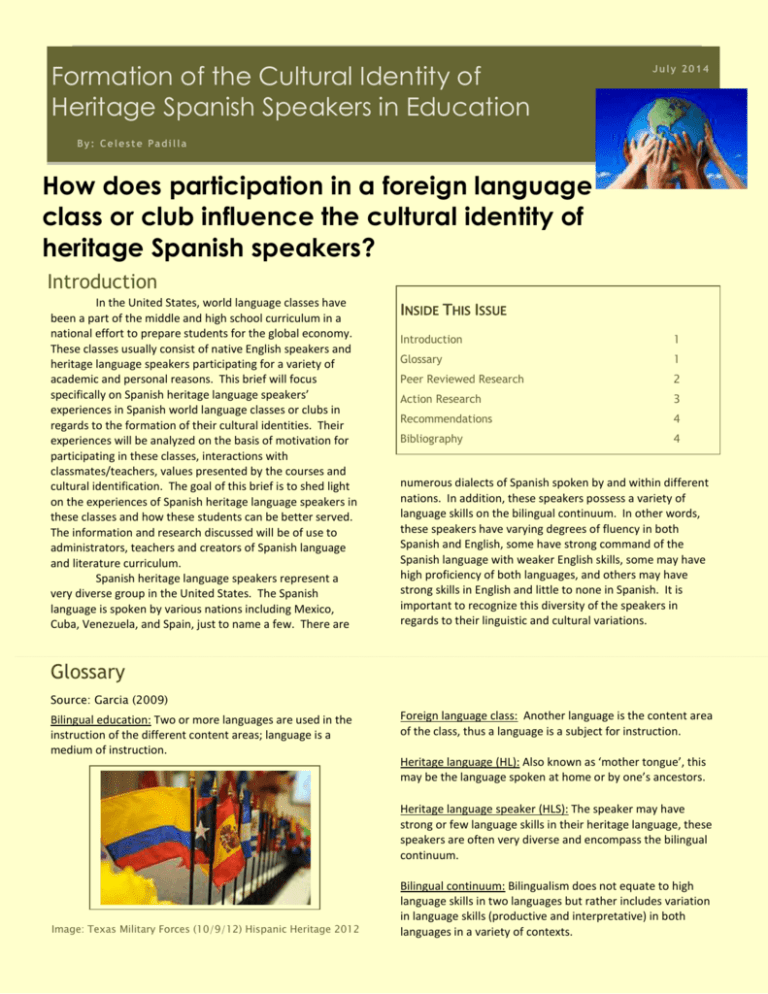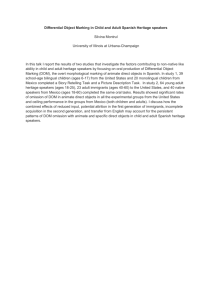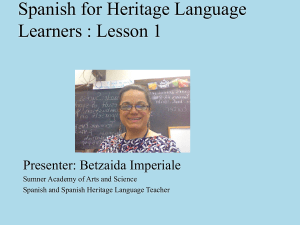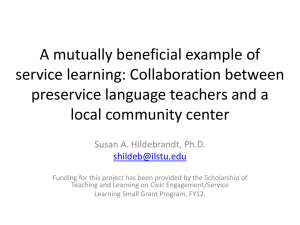Inquiry Brief Document Link
advertisement

HLS Experiences Formation of the Cultural Identity of Heritage Spanish Speakers in Education J u l y 2 04 14 HLS Experiences Page By: Celeste Padilla How does participation in a foreign language class or club influence the cultural identity of heritage Spanish speakers? Introduction In the United States, world language classes have been a part of the middle and high school curriculum in a national effort to prepare students for the global economy. These classes usually consist of native English speakers and heritage language speakers participating for a variety of academic and personal reasons. This brief will focus specifically on Spanish heritage language speakers’ experiences in Spanish world language classes or clubs in regards to the formation of their cultural identities. Their experiences will be analyzed on the basis of motivation for participating in these classes, interactions with classmates/teachers, values presented by the courses and cultural identification. The goal of this brief is to shed light on the experiences of Spanish heritage language speakers in these classes and how these students can be better served. The information and research discussed will be of use to administrators, teachers and creators of Spanish language and literature curriculum. Spanish heritage language speakers represent a very diverse group in the United States. The Spanish language is spoken by various nations including Mexico, Cuba, Venezuela, and Spain, just to name a few. There are INSIDE THIS ISSUE Introduction 1 Glossary 1 Peer Reviewed Research 2 Action Research 3 Recommendations 4 Bibliography 4 numerous dialects of Spanish spoken by and within different nations. In addition, these speakers possess a variety of language skills on the bilingual continuum. In other words, these speakers have varying degrees of fluency in both Spanish and English, some have strong command of the Spanish language with weaker English skills, some may have high proficiency of both languages, and others may have strong skills in English and little to none in Spanish. It is important to recognize this diversity of the speakers in regards to their linguistic and cultural variations. Glossary Source: Garcia (2009) Bilingual education: Two or more languages are used in the instruction of the different content areas; language is a medium of instruction. Foreign language class: Another language is the content area of the class, thus a language is a subject for instruction. Heritage language (HL): Also known as ‘mother tongue’, this may be the language spoken at home or by one’s ancestors. Heritage language speaker (HLS): The speaker may have strong or few language skills in their heritage language, these speakers are often very diverse and encompass the bilingual continuum. Image: Texas Military Forces (10/9/12) Hispanic Heritage 2012 Bilingual continuum: Bilingualism does not equate to high language skills in two languages but rather includes variation in language skills (productive and interpretative) in both languages in a variety of contexts. Along with the hook, the article needs a headline Page 2 HLS Experiences Peer Reviewed Research Motivation Several studies have been conducted in regards to the motivation of Spanish heritage language speakers’ participation in world language classes. Yanguas (2010) revealed that many students choose to enroll in these classes because they want to maintain their language, become a part of their community, relate to their cultural values, and add to their self-concept/identification. In addition, Harklau (2009) conducted ethnographic interviews with heritage speakers to better understand their motivation for participating in Spanish language classes. Many students revealed, similar to Yanguas, the desire to become closer to their communities and heritages. Students, such as Izzie, express both their and their parents’ concerns about heritage and identity. Izzie explains, “She doesn’t want me to not know my language, where I come from and everything. She says you shouldn’t lose that. Cause that’s something you should be proud of and everything.” (Harklau, 2009, p.227). Experience Heritage language speakers have voiced their experiences in world language classes and these experiences are surprising in relation to student motivation for originally enrolling. As was explained earlier, many students enroll in these classes as means to maintain their language, become members of their cultural communities, and/or add to their self-concept. In both, Harklua (2009) and Schreffler (2007) students sought to have a deeper cultural understanding and connection but sustained linguistic exclusion. Both studies discussed the manners in which the students had negative experiences. One important factor is the type of Spanish used in the classroom. As explained earlier, there are various dialects of Spanish spoken globally thus it is important to consider what Spanish is being used in the classroom. Harklau (2009) explains, “So for Izzie’s family, ‘international Spanish’ was not only of little use but was in fact a symbolic betrayal of their language and heritage.” The Spanish language taught in classroom may not be the Spanish that students or their families use thus if students are participating in these classes to improve their language skills to communicate and connect with their communities, learning a different dialect may not fulfill these needs and may further alienate them. In ‘‘She’s always talking about Hispanic culture, and what they believe in. And WE—we, the Hispanics, we get mad sometimes. When she’s speaking about our culture and everything. Because she tells it different than what we know.’’ -Roberto (student) Harklau (2009) --story here.” Image: David Schott (7/2/05) CCDHS Classroom, Miles City addition, some students have experienced linguistic insecurities because they are not familiar with the Spanish being taught, thus they begin to doubt their language skills and are further pushed from their cultural communities. Another significant aspect of the negative experience is the view of heritage speakers in the classroom. These speakers are extremely diverse and occupy the whole bilingual continuum. Schreffler (2007) discusses the impact of these views, “In class, heritage language learners find themselves combating the widely-held assumption of their classmates that they are in the class just to get an easy A (Carreira, 2004). Again, their linguistic similarity to second language learners places them in danger of having their identity negated or ignored, and their linguistic insecurities emphasized.” (p.32) Some heritage speakers are entering the classroom with lower Spanish skills in the hopes to better their skills and connect with their cultures, unfortunately they are greeted with negative assumptions that further exclude them. A common characteristic of Spanish classes is the homogenization of cultural groups into bullet points of important high culture elements. This is usually displayed in a ‘cultural tourism’ fashion, for example, each week or couple weeks a nation is studied in terms of the food, customs, values and music. While on the surface this may seem like a solution to address the various cultural groups of the Spanish language, in reality this approach is more detrimental. According to Harklau, “In all, then, at the very time when Spanish classes came closest to talking about these students’ cultural heritage, at the time when one might expect them to feel most validated and connected with heritage language and culture, the curriculum instead served to distance them from it. Not only were students’ home languages and cultures essentialized and objectified, but the high culture version forwarded by the school was given greater legitimacy than students’ own cultural expertise.” (2009, p.231) Students in this study discussed how they felt they were pushed away from identifying with their cultures because of their ‘lack’ of knowledge about their cultures and the misrepresentation. One way to do this is with the table of contents. A table of contents that has descriptive and enticing headlines will go a long way toward getting the reader beyond the articles on the front page. Page 3 HLS Experiences Action Research Focus In an original research project, a teacher explored the experiences of Spanish heritage language speakers in world language classes and/or clubs. The research emphasized understanding the formation of cultural identity in relation to participation in these courses. Factors such as student motivation, peer interactions, curriculum, cultural identification and presentation of cultures were analyzed. “Her grandmother would correct her and say ‘That is not how we say it’ that’s what her grandmother would say ‘No no no mija!’ cuz she was smart enough to know that this was Castilian Spanish, that it wasn’t Mexican Spanish.” -Gloria Padilla (parent) Methods Qualitative data was collected through the use of ethnographic interviews of three students, a parent, and an educator. Three Spanish language heritage speakers were interviewed in regards to their participation and experience in world language classes in middle and high school. The ages of these participants ranged from 22-32. In addition, two of the participants attended both Pacific Beach Middle and Mission Bay High; the other attended Palm Springs High. These students participated in a combination of Advanced Placement Spanish, Spanish for Heritage Speakers, and Spanish Literature classes. The parent of one of the student participants in the study was interviewed. This interview focused on her perspective of the child’s experience in the classroom. Lastly, an educator was interviewed to illuminate her experiences working with Spanish heritage speakers. This educator conducted a voluntary after school Spanish literature club at Garfield Senior High. While her experiences are not in a world language class, she presents an interesting perspective on the experiences of Spanish heritage speakers in an instructional setting centered on the Spanish language. Results The data collected from this study was minimal and illustrates the experiences of these students, parent, and educator. Further research can be performed with a wider range of participants but the ethnographic interviews still provide valuable information regarding heritage speakers’ experiences in Spanish classrooms and the impacts on cultural identity. “I spoke Spanish differently, it is probably my Cuban-ness. They just thought I spoke funny. The teacher picked up on it and he would correct me all the time.” -Rosalie Sanchez (student) All three of the students discussed similar motivation for joining these classes such as desires to improve their language skills, be able to communicate with family members, and connect more with their communities. In addition, the parent complemented what the other students discussed in terms of motivation; she explains “She wanted to improve her Spanish so she could be more conversational with her grandma and her aunts, and she just thought living here she needed it anyways.” The experiences of the students were also similar despite attending different schools and their age range. Each student experienced disconnection from the Spanish language taught in the classroom to their own Spanish that was spoken at home. Rosalie Sanchez, a student of Cuban decent shared, “I spoke Spanish differently, it is probably my Cuban-ness. They just thought I spoke funny. The teacher picked up on it and he would correct me all the time.” A parent, Gloria Padilla, of Mexican decent shared her child’s experience, “Her grandmother would correct her and say ‘That is not how we say it’ that’s what her grandmother would say ‘No no no mija!’ cuz she was smart enough to know that this was Castilian Spanish, that it wasn’t Mexican Spanish.” These participants expressed linguistic exclusion in the classroom. The interview with the educator provided a unique point of view in terms of the experiences heritage Spanish speakers are having in a class of Spanish instruction but not necessarily a ‘world language class’. A Spanish literature club was held at Garfield Senior High, in which various heritage speakers participated. The educator explained the motivation behind their participation, “I think majority are doing it because they are curious and they want to learn more about Spanish and they want to connect with their families and they want to feel proud.” She also described the discourse in the club, ““We encouraged them to use whatever kind of register they could, to use as much Spanish as they wanted, they could speak in English, they could speak in a hybrid, um they could speak in Spanglish if they wanted to, just so they could feel comfortable communicating.” This educator was cognizant of the values presented in classroom in regards to language and the impact it could have on her students’ cultural identities. Implications It is important to begin to better understand the experiences of heritage Spanish speakers in world language classes in order to provide more supportive and respectful environments for these students. This original research only skimmed the surface of this issue. HLS Experiences HLS Experiences Page 4 Recommendations Curriculum should be analyzed in regards to the underlying cultural assumptions and values it presents. Classroom should acknowledge and respect the linguistic and cultural variation of the speakers in the classroom. Equal value should be placed on all Spanish dialects and variations. Mexican Spanish at the university Pull “They quote.have A phrase or sentence taken from an article level that like appears San Diego in large State letters but middle on theschool, page, oftenhigh within a box to set apartdo from thewhoever article. school, they willitnever that, writes curriculum, whoever wants to write Volume and issue. Volume refersSpanish to the number curriculum, all that Castilian they of years hashigh been in circulation. haveainnewsletter middle and school has already Issuebeen refers to theyou number newsletters written, knowoffor the ages. But published so far in the year. The ninth have newsletter they should do it and they should it in itsavailable.” fifth year of circulation would be Volume 5, Issue 9. -Gloria Padilla (parent) “When people try to teach English or Spanish without making the cultural parts of that clear or explicit then it does the learners a disservice.” -Cheryl Forbes (educator) Teachers should be explicit in regards to the dialect of Spanish presented in the classroom while also acknowledging other variations. Curriculum should steer away from the ‘cultural tourism’ approach to discussing the various Spanish speaking cultures, communities, and nationalities. Heritage speakers should be placed as experts of their cultural groups. In the course of adapting this template to suit your needs, you will see a number of newsletter elements. Bibliography The following is a list of many of them, accompanied by brief definitions. Garcia, O. (2009). Bilingual education in the 21st century: A global perspective. West Sussex: Blackwell Publishing Body text. The text of your articles. Harklau, L. (2009). Heritage speakers’ experiences in new latino diaspora spanish classrooms. Critical Inquiry in Language Byline. A line of text listing the name of the author Studies 6(4), 211-242. of the article. LaFromboise, T., Coleman H. L. K., and Gerton J. (1993) Psychological impact of biculturalism: Evidence and theory. Psychological Bulletin. 114(3) 395-412. Caption text. Text that describes a graphic. A caption should be a short but descriptive full Schreffler S. B. (2007) Hispanic heritage language speakers in the united states: Linguisticit exclusion education. Critical sentence. For photos, ought toinexplain what’s Inquiry in Language Studies. 4(1), 25-34. happening without being insultingly obvious. It should also add to the reader’s understanding of the Yanguas, I. (2010) A quantitative approach to investigating spanish heritage language speakers’ characteristics and by, for example, explaining orA global motivation: A preliminary study. Hispania 93(4), 650-670.Garcia,photo O. (2009). Bilingual education in the prominent 21st century: unusual objects. perspective. West Sussex: Blackwell Publishing “Continued from” line. A line of text indicating the









